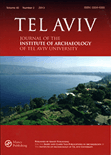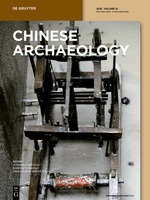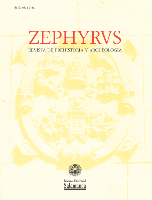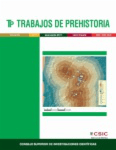
Tel Aviv-Journal of the Institute of Archaeology of Tel Aviv University
Scope & Guideline
Exploring the Depths of Archaeological Discovery
Introduction
Aims and Scopes
- Archaeological Excavations and Reports:
The journal regularly publishes detailed reports on archaeological excavations, providing insights into new findings, methodologies, and interpretations of material culture. - Material Culture and Artifact Analysis:
A significant focus is on the analysis of artifacts, including pottery, tools, and inscriptions, to understand the socio-economic and cultural contexts of ancient societies. - Chronology and Typology Studies:
Research often involves revising and establishing chronologies and typologies of various archaeological materials, contributing to a better understanding of regional developments over time. - Cultural and Religious Practices:
The journal explores the cultural and religious dimensions of ancient societies, including cultic practices and architectural developments, shedding light on their social structures. - Interdisciplinary Approaches:
Utilizing interdisciplinary methodologies, including archaeobotany, archaeometallurgy, and geoarchaeology, the journal highlights the integration of various scientific techniques in archaeological research.
Trending and Emerging
- Interdisciplinary Methods in Archaeology:
There is a growing trend towards the application of interdisciplinary approaches, such as archaeobotany and archaeometallurgy, enhancing the understanding of ancient societies through diverse scientific techniques. - Cultural Identity and Political Structures:
Recent studies increasingly focus on cultural identity and political organization in ancient societies, particularly in relation to royal estates and administrative practices, reflecting contemporary interests in socio-political dynamics. - Environmental Archaeology:
Research on environmental factors, including archaeobotanical remains and geoarchaeological contexts, is gaining traction, emphasizing the interaction between ancient communities and their environments. - Chronological Revisions of Key Sites:
There is a notable emphasis on revising the chronology of significant archaeological sites, particularly in Jerusalem and surrounding areas, which is crucial for understanding historical developments. - Cultic and Ritual Practices:
The study of cultic spaces and ritual practices in various periods, particularly the Middle Bronze Age, is emerging as a significant theme, reflecting interests in the spiritual lives of ancient peoples.
Declining or Waning
- Late Antiquity Studies:
Research focusing specifically on Late Antiquity has seen a decline, possibly due to a shift towards earlier periods and more foundational archaeological studies. - Roman Military Archaeology:
The exploration of Roman military sites and inscriptions, while still present, has become less frequent, indicating a potential waning interest in this specific aspect of archaeology. - Ceramic Typology of the Late Bronze Age:
Although ceramic studies remain vital, there appears to be a reduced emphasis on Late Bronze Age ceramics, with more focus shifting to Iron Age and earlier periods. - Anthropological Approaches to Archaeology:
There has been a decrease in anthropological perspectives applied to archaeological findings, which may suggest a trend towards more traditional archaeological methodologies. - Epigraphic Studies:
The frequency of studies focused exclusively on inscriptions and epigraphy has diminished, indicating a broader trend towards integrating epigraphic evidence with other archaeological data.
Similar Journals

Vjesnik Arheoloskog Muzeja u Zagrebu
Exploring the Depths of Croatia's Archaeological RichesVjesnik Arheoloskog Muzeja u Zagrebu, published by the ARHEOLOSKI MUZEJ & ZAGREBU, is a vital platform for disseminating scholarly research in the field of archaeology. With its Open Access model established in 2007, the journal ensures that vital archaeological findings and theories are accessible to a global audience, fostering greater collaboration and knowledge-sharing among researchers, professionals, and students. The journal is based in Croatia and has been an essential part of the academic landscape since its inception, with convergence noted in years such as 1979 and 1981, and continuing consistently from 2014 to 2023. While it currently holds a Q4 ranking in both the Arts and Humanities and Archaeology categories, its contributions to the understanding of archaeological heritage in the region are invaluable. Positioned within the 30th percentile among its peers in Scopus rankings, the journal endeavors to elevate the discourse around archaeological practices and findings, making it an important resource for anyone engaged in the pursuit of archaeological knowledge.

Deltion of the Christian Archaeological Society
Exploring the Depths of Christian History Through Archaeological InsightDeltion of the Christian Archaeological Society (ISSN: 1105-5758, E-ISSN: 2241-2190), published by the Christian Archaeological Society in Athens, Greece, stands as a pivotal source of scholarly work within the realm of Christian archaeology. This journal is dedicated to disseminating high-quality research that promotes the understanding of Christian history, heritage, and archaeological practices. Though it operates under traditional access options, it provides a comprehensive platform for researchers and professionals alike, fostering dialogue and collaboration within the archaeological community. With a commitment to advancing knowledge, the Deltion aims to support both established scholars and emerging voices, reinforcing the significance of archaeology in interpreting religious narratives and cultural contexts. Researchers, students, and professionals interested in the intersections of archaeology, history, and theology will find this journal an invaluable resource in their scholarly pursuits.

Anadolu Arastirmalari-Anatolian Research
Elevating Research on the Anatolian ExperienceAnadolu Arastirmalari-Anatolian Research, published by ISTANBUL UNIVERSITY, is a prominent open-access journal dedicated to the exploration of history, archaeology, and related fields. Since its transition to open access in 2017, the journal has become a vital resource for scholars and practitioners, facilitating the dissemination of innovative research findings. With a strong focus on the intricacies of Anatolian history and archaeology, the journal has earned notable recognition, achieving a Q1 ranking in History and Q2 rankings in both Archaeology and Arts and Humanities categories as of 2023. This positions it among the foremost journals in its field, providing an essential platform for interdisciplinary research and discourse. The journal's impact factor is evidenced by its significant citation metrics and rigorous editorial standards, aiming to contribute meaningfully to scholarly dialogue and knowledge production. Researchers, professionals, and students alike will find this journal indispensable for understanding the rich tapestry of Anatolian culture and heritage.

Archeologicke Rozhledy
Advancing archaeological scholarship for a global audience.Archeologicke Rozhledy, published by the Academy of Sciences of the Czech Republic, Institute of Archaeology, is a pivotal open-access journal dedicated to advancing the field of archaeology. Since transitioning to open access in 2019, it has made significant strides in disseminating high-quality research, serving as a vital resource for researchers, professionals, and students alike. With an ISSN of 0323-1267, the journal has gained recognition for its contributions in the domains of arts and humanities, particularly archaeology, as evidenced by its 2023 Q2 ranking in both categories. Operating out of the historical city of Prague, the journal encompasses a broad scope of archaeological scholarship, reflecting a commitment to interdisciplinary approaches and fostering dialogue within the global archaeological community. With its notable Scopus rankings—#115/413 in Arts and Humanities and #113/354 in Social Sciences—Archeologicke Rozhledy stands as a crucial outlet for innovative research and scholarly exchange.

Slovenska Archeologia
Uncovering insights that shape our understanding of the past.Slovenska Archeologia is a prominent journal published by the Slovak Academy of Sciences, Institute of Archaeology, dedicated to advancing the field of archaeology through rigorous scholarly research and insightful scholarship. With an ISSN of 1335-0102 and an E-ISSN of 2585-9145, this journal has been a vital platform for archaeologists and academics since its inception, converging its insightful publications from the years 2017 to 2023. Awarded a Q2 ranking in the field of archaeology across both arts and humanities categories, it holds a respectable position in the Scopus rankings, recognizing its contributions to the discipline. Based in Slovakia, the journal is an essential resource for professionals, researchers, and students interested in archaeological findings and methodologies. While it does not currently offer Open Access options, its commitment to promoting high-quality research makes it a valuable addition to the academic community.

Chinese Archaeology
Exploring the Rich Tapestry of Chinese HeritageChinese Archaeology, published by WALTER DE GRUYTER GMBH, is a leading journal dedicated to the exploration and study of China's rich archaeological heritage. With an ISSN of 2160-5025 and an E-ISSN of 2160-5068, this journal serves as an essential platform for scholars, researchers, and enthusiasts in the field of archaeology, offering a blend of original research articles, reviews, and critical essays that address both contemporary issues and historical narratives. While it currently operates under a conventional access model, making cutting-edge research available to a select audience, it plays a crucial role in advancing knowledge about China's archaeological sites, artifacts, and past civilizations. Given the increasing interest in Eastern archaeology and its significance in a global context, Chinese Archaeology is positioned as a pivotal resource for understanding and interpreting the complexities of China’s historical evolution. Researchers and academics are encouraged to contribute and engage with this vital field of study to foster greater insights and innovations.

Zephyrus-Revista de Prehistoria y Arqueologia
Illuminating History Through Innovative ScholarshipZephyrus-Revista de Prehistoria y Arqueologia, published by UNIV SALAMANCA, EDICIONES, is a renowned academic journal dedicated to the fields of archaeology and prehistory. Since its inception in 1950, the journal has embraced an Open Access model, facilitating widespread access to cutting-edge research and scholarly discourse while fostering global collaboration among researchers. Based in Salamanca, Spain, this journal has achieved remarkable recognition, evidenced by its Q1 rankings in Archaeology and History as of 2023, and impressive Scopus standings across various categories, including an 83rd percentile in History. The journal's comprehensive scope since 2011 has made it a vital resource for academics seeking to deepen their understanding of human history through archaeological insights. Zephyrus not only provides a platform for disseminating innovative research findings but also serves as a bridge between historical scholarship and contemporary archaeological practices, ensuring that researchers, professionals, and students alike have access to the latest developments in the field.

Trabajos de Prehistoria
Pioneering Research That Shapes Our Understanding of Ancient CivilizationsTrabajos de Prehistoria is a distinguished peer-reviewed journal published by the Consejo Superior de Investigaciones Científicas (CSIC) since 1988, and it has established itself as a vital resource in the field of archaeology and prehistory. With an impressive impact factor and an open access policy, the journal aims to disseminate high-quality research that contributes to the understanding of human history and prehistorical studies. This Spanish journal has consistently ranked in the top quartile (Q1) in both the Arts and Humanities and Social Sciences categories, reflecting its significance in advancing archaeological scholarship, with Scopus rankings placing it in the 85th percentile among its peers. Covering a broad scope of topics related to archaeology, it serves as a platform for innovative research that connects researchers, professionals, and students globally, enhancing academic dialogue and fostering interdisciplinary collaboration. Based in Madrid, European researchers and global academics alike benefit from its open access model, promoting wider distribution and accessibility of foundational studies in the field.

Revue Archeologique du Centre de la France
Illuminating the Archaeological Riches of Central FranceRevue Archeologique du Centre de la France is a prestigious academic journal dedicated to the field of archaeology, with a special focus on the rich historical and cultural heritage of central France. Published by FED EDITION REVUE ARCHEOLOGIQUE CENTRE FRANCE, this journal has been an open-access platform since 2004, ensuring that researchers, professionals, and students can freely access cutting-edge archaeological findings and scholarly discussions. With an acute emphasis on disseminating knowledge and fostering ongoing dialogue in archaeology, Revue Archeologique du Centre de la France serves as a vital resource for those keen to explore the complexities of French archaeological studies. Housed in Tours, this journal not only highlights regional heritage but also situates it within broader archaeological frameworks, making it an essential contribution to the field. Researchers can look forward to engaging with a diverse array of articles that cover both theoretical and applied aspects of archaeology, bolstering the understanding of our shared past.

Kratkie Soobshcheniya Instituta Arkheologii
Pioneering Insights in the HumanitiesKratkie Soobshcheniya Instituta Arkheologii is a prestigious academic journal published by IZDATELSTVO NAUKA, specializing in the fields of archaeology and history. With an ISSN of 0130-2620, this journal has established itself as a vital resource for scholars, researchers, and students engaged in the humanities, particularly within the Russian Federation. Recognized for its high-quality contributions, it has achieved a remarkable Q1 ranking in both Archaeology and History for the year 2023, demonstrating its significant impact and relevance in these disciplines. Although it does not provide open access, the journal's robust positioning in Scopus — ranking #634 in History and #208 in Archaeology — further attests to its scholarly authority and the insightful research it disseminates. The journal covers a comprehensive range of topics, facilitating a deeper understanding of archaeological practices and historical methodologies, thereby fostering academic dialogue and knowledge advancement from 2018 through 2024. Addressing an international audience of professionals and students alike, Kratkie Soobshcheniya stands as a cornerstone for innovative research in archaeology and history.